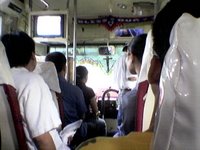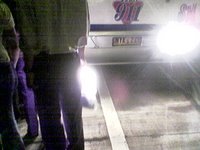Monday, May 15, 2006
reality

”sorry po, hindi na po mauulit..”
”hindi na talaga mauulit ang ginawa mo.”
”po?”
”heto tangapin mo.”
(man hands girl envelope)
”last pay mo yan. mag mula ngayon hindi ka na dito magtratrabaho.”
“wag po. kelangan ko po ang trabahong ito.”
“pasensya ka na ija at ngayon ang last day mo. wag ka nang papasok bukas.”
odd. everyone is glued to the Koreanovella on the television. I nudge my friend with my elbow and tell him that the girl on the TV just got fired. my friend, in reply, snorts in my general direction.
next scene:
the girl moves along on a sidewalk. problems rushing all around her head. she brings out her last pay, someone bumps her from behind and she accidentally drops all her money. gusts of wind follow. the girls money scatters all around. the man next to me exclaims:
“kawawa naman!”
I look at my friend. he is half asleep.
Its 10 am in the morning, Saturday. outside, Tropical Storm Caloy relentlessly lashes at everything; the trees bow to its fury, the roads are littered with debris. In a corner, under an overpass is a man sipping coffee from an immaculate white styro cup.
I guess the bus can really blot out reality sometimes. and I love it.
Monday, May 08, 2006
smoked

there is something wrong with my vision. it’s getting a bit blurry.
someone shouts: “usok usok!”
the inside of the bus is quickly enveloped with dark carbon monoxide. we pull over to the curb and slowly everyone goes down. Just my luck, I’m seated at the back part so I have to wait for almost all the passengers to get out before I get to breath the fresh South Luzon Expressway (SLEX) air.
everyone in the bus almost died.
carbon monoxide is the most toxic substance that a daily commuter will come in contact with. you cant smell, see or taste it which is why its considered as one of the most common type of accidental poisoning in the world.
symptoms:
shortness of breath
mild nausea
mild head ache
see why it can easily kill. the symptoms above can be blamed on hundreds of small causes, and by the time you figure out its carbon monoxide, it would be too late. Know that high levels of carbon monoxide in a contained environment can kill with in minutes.
And mind you, this aint the first time I’ve experienced carbon monoxide inside a bus. The last time I felt its presence, I was sharp enough to inform the other bus riders about the threat followed by me promptly going down. The funny thing was that no one followed me. here’s the Twilight Zone tragi-comic image in my head at the time:
I’m in a field surrounded by soldiers. I shout: are you with me!!! (to the top
of my lungs). Then I charge against the enemy, all by myself. Heee heee. I get
shot in the leg and scream: you bastards! The carbon monoxide will kill
you all!!!
Fact is, a lot of people are ignorant about the dangers of carbon monoxide. I once heard an urban legend on how this girl died in the parking lot of some mall after falling asleep in her air conditioned car. turns out the exhaust of her car seeped in and killed her as she slept. There’s an urban legend but I never hear, read or watch about it on the news. what are we to make of this?
“sakay sakay!”
the Kunduktor asks everyone to go back in. i ask the dude before I go up the bus steps:
“naayos nyo?”
“fanbelt fanbelt.”
“fanbelt?”
“ayos na.”
and so I go in, sniffing around for a doubtful scent. but then I’m midway to Alabang from Edsa, on the SLEX. I have no choice I guess.
Tuesday, May 02, 2006
regulate

they want to self-regulate. the Integrated Metro Manila Bus Operators Association (IMBOA), wants the government to de-regulate the fares of busses to help them survive the skyrocket movement of fuel prices.
The meat of their cause focuses on this: the fuel industry of the Philippines is deregulated so that the major fuel providers can adjust their prices to protect themselves from the volatile international oil market. IMBOA argues that the same should be true with bus fares because 30 to 40 percent of a bus operator’s expenses are fuel based.
Quotable quote:
“The oil industry is deregulated, but we, who are operating under it are a regulated industry.”
–Claire dela Fuente, IMBOA President
they make sense, but then we need to dig deeper, a pros cons list is in order:
pros:
survival. less bus firms will fold up and die when bus fares are deregulated. They can adjust prices according to the current price of fuel and keep their profits steady. The more bus firms that survive, the more busses we have, the more happy the commuting public will be.
power of choice. with deregulation comes the price war. Some busses will charge less while others will charge premium rates. Some busses will be crappy, others will be more well kept. The riding public will be given a choice and this is good. The only hitch here is that some busses will have the gal to charge premium rates despite dilapidated, air polluting, insect infested, funny smelling busses.
cons:
anger. on both the side of the passengers and the bus Kunduktor. Passengers who get to ride the more expensive busses will complain about the fare, Kunduktor’s will then say:
a: “Kung ayaw mo mag bayad e di sa iba ka sumakay!”
b: “Hindi naman ako ang nagsabi na ganito ang singil namin, ang management!”
from here, passenger and Kunduktor will now be tied in a heated circular, tit-for-tat argument. some passengers might join in and gang up on the poor bus collector, other passengers may just opt to go down and seek another ride.
confusion. Fuel prices change from day to day; imagine deregulated fares changing in the same manner based on the local prices of gas/diesel. This is not good. The poor will be torn with the frequent adjustments which will be quicker to increase than to decrease.
There is a reason why our oil industry is deregulated: the price of oil in any country must be defined by FREE market forces and it must not be artificially influenced via subsidies or the like. Should the same train of thought be applied to the transport industry? Is fare deregulation the answer to the cash problems of our bus operators vis-à-vis the price of fuel. I don’t really know.
I remember riding a jeep one day; it was the first morning of the newly implemented P7.50 minimum fare. I paid the driver and he said:
“Wag muna.”
It took close to a full month before everyone followed the new minimum fare for PUJ’s. Some drivers refused to immediately pass on this new burden to their passengers, some of which refused to pay the correct amount unless the driver had the new tariff matrix posted in his/her jeep. It took a while for everyone to get used to it; what of deregulated bus fares? I feel that it will take a long struggle before everyone gets to accept this new rule. Maybe someone can research on how it is done in other countries. Honestly, I’d be dead interested to know how it is implemented, that is, if it ever exists.
One thing is certain though, all sides must be heard before anything is set in stone. The more planning involved the more chances of success. lets regulate.
